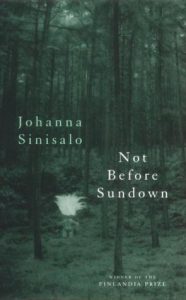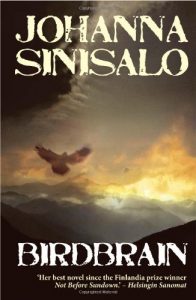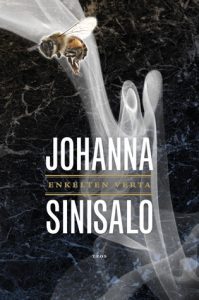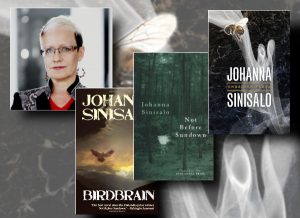Interview with Johanna Sinisalo (THE BLOOD OF ANGELS)
Johanna Sinisalo is a pioneer of the Finnish Weird. Her debut novel Not Before Sundown (2000, translated 2003) won the prestigious Finlandia prize in her native Finnish and won the James Tiptree, Jr Award on its translation into English. The novel is a wonderful mix of the speculative and the realist, imagining an alternative Finland in which trolls really exist from the perspective of the gay community in Sinisalo’s hometown of Tampere. Her other novels translated into English include Birdbrain (2008, translated 2011), a masterpiece of the eco-Weird, the utterly wonderful The Blood Of Angels (2011, translated 2014) which happens to be the interviewer’s favourite book, and The Core Of The Sun (2013, translated 2016), a feminist dystopia which won the Prometheus Award. She is a prolific writer of short stories, and her translated story ‘Baby Doll’ was nominated for the Nebula Award in 2009. In her native Finnish, she has won the Atorox Award for best science fiction short story six times. Sinisalo has also written for television and comics, as well as working as an editor.
Johanna Sinisalo was kind enough to speak to the Fantasy Hive via email.
Your debut novel Not Before Sundown won the Finlandia prize and then won the James Tiptree, Jr Award when it was translated into English. What do you think made the book so resonant?
I honestly do not know. I assume the work was perhaps considered as something profoundly Finnish (and thus a little bit exotic, I guess) and that’s why it was so appreciated. I also have understood that many readers and publishers have liked the way the book is trying to balance itself on the very thin and wobbly line between contemporary fiction and genre fiction – in many countries it has not even been labelled as fantasy or sci-fi, although the story actually takes place in an alternate history of Finland. But also, there might have been some ideas in the book that may have been considered a bit controversial in that particular time, like all the main characters being gay, seeing the world from their own perspective and not assuming the victim position which had been almost a tradition in literature with gay protagonists. In addition to that, in this novel the barrier between humanity and the animal kingdom was questioned in a way that has not possibly been very much processed before in contemporary fiction.
Not Before Sundown is set in a world where trolls are discovered to be real animals as opposed to mythic beings. Would you be able to tell us a bit about the importance of trolls in Finnish mythology?
 Mythical beings that live in the wilderness and resemble us but are not exactly like us, are present in about every mythology there is on Earth – tiny people, hairy people, giant people, pretty fairies, friendly pixies, mischievous gnomes. The Finnish folklore does not dramatically differ from most of those which present trolls, elfs, goblins, dwarfs, wood spirits, bigfoots, yetis, you name them. There are some hypotheses that our ancestors have during the history of humankind met Neanderthals and those sturdy, hairy parallels of us might have created some of those myths. In Finnish folklore, those almost human-like forest inhabitants have always been intelligent but are still a little bit lesser creatures than “we humans”. The most exciting discovery I made when I researched the Finnish troll tales was the fact that the original folklore was repeatedly comparing those big, strong mythical creatures and much smaller and weaker, but witty humans. And, after a very careful research, I realised that in the times the Christian religion was introduced to Finland, a lot of those fairy tales were copied almost verbatim to children’s stories about a strong but stupid Satan, who tried to confront the humans, but they managed always to defeat the devil with their better knowledge. It was something like a conceptual breakthrough for me, as I understood that those tales were pure propaganda. The trolls were perhaps invented when the early humans inhabited the northern woodlands and it was necessary to create mythical beings, which could (and would) e.g. kidnap children who did not stay in the vicinity of the house; but those tales were also necessary for educating children to internalize that the creatures of the forests were and should be subordinated by humankind, because “we” were much more intelligent than them and we could outwit them whenever there was a need.
Mythical beings that live in the wilderness and resemble us but are not exactly like us, are present in about every mythology there is on Earth – tiny people, hairy people, giant people, pretty fairies, friendly pixies, mischievous gnomes. The Finnish folklore does not dramatically differ from most of those which present trolls, elfs, goblins, dwarfs, wood spirits, bigfoots, yetis, you name them. There are some hypotheses that our ancestors have during the history of humankind met Neanderthals and those sturdy, hairy parallels of us might have created some of those myths. In Finnish folklore, those almost human-like forest inhabitants have always been intelligent but are still a little bit lesser creatures than “we humans”. The most exciting discovery I made when I researched the Finnish troll tales was the fact that the original folklore was repeatedly comparing those big, strong mythical creatures and much smaller and weaker, but witty humans. And, after a very careful research, I realised that in the times the Christian religion was introduced to Finland, a lot of those fairy tales were copied almost verbatim to children’s stories about a strong but stupid Satan, who tried to confront the humans, but they managed always to defeat the devil with their better knowledge. It was something like a conceptual breakthrough for me, as I understood that those tales were pure propaganda. The trolls were perhaps invented when the early humans inhabited the northern woodlands and it was necessary to create mythical beings, which could (and would) e.g. kidnap children who did not stay in the vicinity of the house; but those tales were also necessary for educating children to internalize that the creatures of the forests were and should be subordinated by humankind, because “we” were much more intelligent than them and we could outwit them whenever there was a need.
This very widely spread myth has been parroted thorough ages: which species is the best, the most able, and the undisputed king of the creation? Humans! And in consequence, we do not want to recognize the conscience, rationality and cognitive skills of any beings that are classified as “animals”. Not even when scientific studies prove indisputably that the cognitive skills of many animals are very developed and often totally comparable to our abilities.
But as long as we believe in our false superiority, we will do enormous harm to all of those beings who are almost like us, but in some ways different from us. Any slight dissimilarities create in our minds a concept of otherness, which is much in use also among our very own species. We have not only created the great divide between nature and culture, but myriad great divides inside humanity (racism, homophobia, misogyny / chauvinism, religious prejudices, economical classes, you name them) because we have been fed that propaganda and our thoughts have been modified from our very births than there are those who are “we” and there are “those lower others” that we should hate, fear, subordinate, exploit and kill. The importance of what troll mythology tells about humanity is not limited inside the borders of Finland at all.
Your novel Birdbrain shows the desire to control and dominate nature that can be found in the attitude of some hikers and wilderness enthusiasts. What drew you to this idea?
 In my honest opinion, most of the hikers and wilderness enthusiasts just enjoy to witness the prosperity and diversity of nature instead of having a need to “conquer” or control it. But I admit that there is a character in Birdbrain who enters the wilderness like it was an amusement park but equipped with latest technology like he were stepping into outer space. I thought that the characters in Birdbrain do not even think that they may be seen as trying to control and dominate – they just crave extreme and unique experiences, and that is best achieved by going to most “untouched” terrain as possible – to some people an adventure is not an adventure at all, if very many people have been there and done that before them.
In my honest opinion, most of the hikers and wilderness enthusiasts just enjoy to witness the prosperity and diversity of nature instead of having a need to “conquer” or control it. But I admit that there is a character in Birdbrain who enters the wilderness like it was an amusement park but equipped with latest technology like he were stepping into outer space. I thought that the characters in Birdbrain do not even think that they may be seen as trying to control and dominate – they just crave extreme and unique experiences, and that is best achieved by going to most “untouched” terrain as possible – to some people an adventure is not an adventure at all, if very many people have been there and done that before them.
How much of Birdbrain was inspired by your own hiking experience?
I have myself hiked those walks or routes that are described in the novel, so I knew exactly the terrain the characters were dealing with. Everything else is fiction, except the descriptions of the behaviour of kea birds – those parrot relatives are more than scary in their intelligence.
The Blood Of Angels is about the idea from folklore that bees can travel between worlds. What originally drew you to that piece of folklore?
The Blood Of Angels is basically discussing the Western attitude towards death, on very many macro and micro levels. Are we considering a steak on our plates as a funeral? If someone has a presence in the internet, are they ever dead? Why we are happily watching people die in fictional entertainment, but have to carefully tiptoe around a death in the neighbouring family? Why the life of a human individual is always priceless, but a human-caused extinction of a whole species is something that just happens? Why do we have so many myths of resurrection and immortality? When I researched bees for the actual plot – the worldwide threat of honey polluters facing extinction – I learned a lot about mythologies concerning bees. They are sacred in very many cultures, and they are symbols of resurrection and messengers of Gods. In the Finnish national epic Kalevala a young hero dies and is thrown to the black river of Tuonela (Underworld), but his mother enters Tuonela and resurrects her son with a potion, that a bee brings to her from the domains of gods.
The novel also explores human grief alongside concerns about animal rights. What made you want to explore these two ideas together?
Because the loss of life is always sad, and we should really stop thinking of animals not as robots made of meat but living entities with just that one life what we have, too.
The Core Of The Sun is your most recent novel to be translated into English, and is a dystopian novel about eugenics and the subjugation of women set in an alternate Finland. What were the inspirations for this novel?
 The most important trigger was the aspiring male rights movement. Those guys seem to think that having sex with someone is a basic human right. (No, it’s not. On the contrary, it is a basic human right to be able to freely choose one’s sex partner and if one wants to have sex at all.) Interestingly enough, if those most loud male rights touters just wanted a piece of pussy, there would be a lot of volunteers in the women’s age bracket of 40+, but somehow they are not that interested in that opportunity. It almost looks like they were trying to sell the idea that having sex just with young and pretty women should be a basic human right and so, hey, let’s ditch the basic human rights of these women!
The most important trigger was the aspiring male rights movement. Those guys seem to think that having sex with someone is a basic human right. (No, it’s not. On the contrary, it is a basic human right to be able to freely choose one’s sex partner and if one wants to have sex at all.) Interestingly enough, if those most loud male rights touters just wanted a piece of pussy, there would be a lot of volunteers in the women’s age bracket of 40+, but somehow they are not that interested in that opportunity. It almost looks like they were trying to sell the idea that having sex just with young and pretty women should be a basic human right and so, hey, let’s ditch the basic human rights of these women!
This concept inspired me to invent a world where every woman is indoctrinated to be always available for sex – wouldn’t that be an utopia for quite a lot of men? But it would also be a dystopia for almost every woman. I wanted to explore that idea, but I also have always wanted to write about very hot chili peppers. So I wrote The Core of the Sun, and it was so much fun.
Where did the idea of chilli peppers so powerful they can cause hallucinations come from?
I’m a capso (which term in my novel’s world means a capsaicin addict – capsaicin being the chemical that causes the burning sensation in hot chilies) myself and I know very well that when the heat of the chili is almost intolerable one gets a kind of a pleasant buzz. That is perfectly natural – it’s much like a runner’s high, in which the brain also starts to secrete endorphins to neutralize the pain and strain. Hallucinations are, too, one of our bodies’ defence reactions when the system meets an extreme crisis – an old trick of shamans, who slashed their bodies with knives or ate toxic substances to reach altered states of consciousness.
Your stories often explore ideas around sexuality and gender. What makes speculative fiction and fantasy such powerful tools for confronting these ideas?
Because one is allowed to extrapolate more freely in speculative fiction about sexuality and gender – the reader does not take as easily a moral standpoint when it’s obvious this story is not dealing with any known reality.
Your novels are frequently told in a fragmented way, using documents, quotations and references to other texts that are interspersed with the narratives. What drew you to this approach?
I have tried to imitate the general process of a person when they are achieving knowledge about a certain subject or concept. If I want to sell the reader the idea that trolls are a wild mammal species living in the woodlands of Scandinavia, I make them do half of the work themselves and force them to put together the concept from diverse bits and pieces of information. I think everybody collects their own subjective idea of e.g. a nuclear plant: one compiles in their brain Three Mile Island and/or Chernobyl, fragments of conversations about energy alternatives you have overheard, there are ads and newsflashes one has heard and seen, and picturing Homer Simpson at his work, and all of those are the clump of details you call an idea of a nuclear plant.
The novels often quote from material they are in dialogue with, like how Not Before Sundown quotes sources from Finnish mythology or Birdbrain quotes Conrad’s Heart Of Darkness. How does this give your novels a special relationship to the works they are in dialogue with?
In part I perhaps answered that already above (about the bits and pieces). But quoting Conrad’s Heart Of Darkness in Birdbrain served another kind of dialogue: it mirrored the idea of humans entering the wilds they really do not know enough about, but they blindly (and foolishly) trust in their superiority.
Your short story ‘Baby Doll’ was nominated for the Nebula award. What was that experience like?
When one lives in a country with only about 5 million inhabitants and almost no one but the Finns themselves can speak our language, even getting translated into the Anglo market is very rare. Getting nominated for an international and a very prestigious award was something that exceeded even my own most crazy pipe dreams.
You coined the term ‘Finnish Weird’ to describe your writing and that of your peers in Finland. How does the Finnish Weird differ from the Weird or the New Weird?
 It’s written by Finns or has Finnish elements in it. That’s really the only difference. Also, it is pretty much just a marketing term, an umbrella above all genres that are not realism. I coined the term because in Finland we do not write that many books that are “pure” sf or fantasy or horror – mostly our non-realistic works are hybrids of several genres or more like magical realism (or weird) than classical science fiction or LoTR-type fantasy. A lot of my colleagues did not like that their works were pigeonholed into either sf or fantasy (me included) because these works did not, in their own opinion, really represent those genres. Then I saw in 2010 an excellent Finnish movie called “Rare Exports”, the real story behind Santa Claus, I knew in a flash that it had a genre of its own – very Finnish, very weird. Something that I could relate to, and so Finnish Weird was born.
It’s written by Finns or has Finnish elements in it. That’s really the only difference. Also, it is pretty much just a marketing term, an umbrella above all genres that are not realism. I coined the term because in Finland we do not write that many books that are “pure” sf or fantasy or horror – mostly our non-realistic works are hybrids of several genres or more like magical realism (or weird) than classical science fiction or LoTR-type fantasy. A lot of my colleagues did not like that their works were pigeonholed into either sf or fantasy (me included) because these works did not, in their own opinion, really represent those genres. Then I saw in 2010 an excellent Finnish movie called “Rare Exports”, the real story behind Santa Claus, I knew in a flash that it had a genre of its own – very Finnish, very weird. Something that I could relate to, and so Finnish Weird was born.
As well as novels and short stories, you’ve also written for comics, television and film. How do you approach these different mediums?
Writing for those visual arts truly is very different from writing my own prose. When I’m writing e.g. a novel, I’m thinking words, when writing comics, television and film I’m thinking pictures and visions. And in addition, all those latter arts are based on teamwork, one never works alone or almost alone with them like a novelist does. Television and film are, for obvious reasons, financed in so extremely different way than literature, that the production process is like from another planet.
You have four novels and tens and tens of short stories that have not yet been translated into English. Are we likely to see new English translations at any point soon? Which one would you most like to have translated?
My agent works every day trying to sell my novels and short stories abroad and of course the hopes are high that some further English rights will be sold soon. If I could choose the next one to be translated, it perhaps would be the next novel (presented below) or the 2020 published The Strangers Inside, which won a major national horror novel competition and is indeed horror, but with a very sci-fi-esque twist.
What’s next for Johanna Sinisalo?
My new novel is launched in August. It’s called The Storm Flute – Ukkoshuilu in Finnish – and in it I peek back into ancient Assyria and also a bit closer, into 2018, with a meteorologist as the protagonist. The book’s back cover states as follows: “A masterful novel about the thin line between knowledge and belief, The Storm Flute is a love letter to the weather, a fierce, global story of the destructive power of the human desire for control.”
Thank you Johanna Sinisalo for speaking with us!

